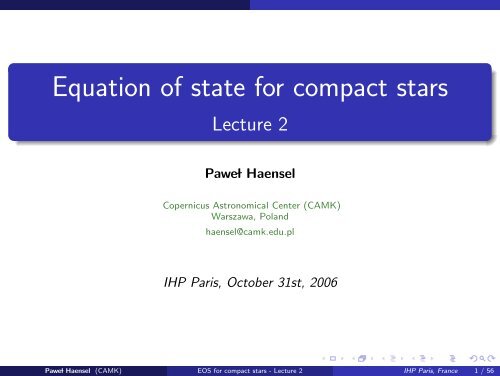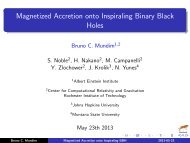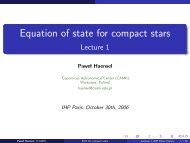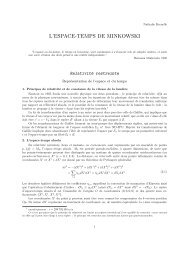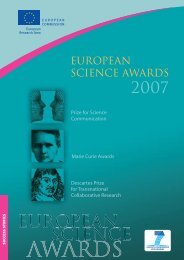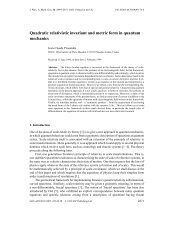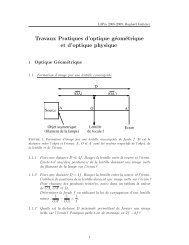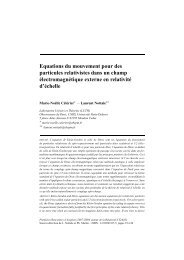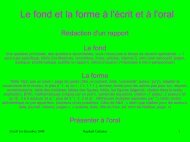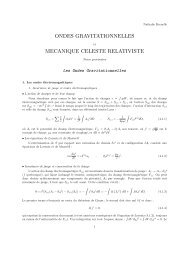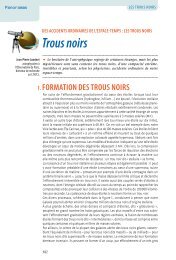Equation of state for compact stars Lecture 2 - LUTH
Equation of state for compact stars Lecture 2 - LUTH
Equation of state for compact stars Lecture 2 - LUTH
You also want an ePaper? Increase the reach of your titles
YUMPU automatically turns print PDFs into web optimized ePapers that Google loves.
<strong>Equation</strong> <strong>of</strong> <strong>state</strong> <strong>for</strong> <strong>compact</strong> <strong>stars</strong><br />
<strong>Lecture</strong> 2<br />
Pawe̷l Haensel<br />
Copernicus Astronomical Center (CAMK)<br />
Warszawa, Poland<br />
haensel@camk.edu.pl<br />
IHP Paris, October 31st, 2006<br />
Pawe̷l Haensel (CAMK) EOS <strong>for</strong> <strong>compact</strong> <strong>stars</strong> - <strong>Lecture</strong> 2 IHP Paris, France 1 / 56
Strong interactions and neutron <strong>stars</strong><br />
Neglecting NN interactions =⇒ a model <strong>of</strong> neutron <strong>stars</strong><br />
built <strong>of</strong> ideal Fermi gas <strong>of</strong> neutrons. This is what<br />
Oppenheimer & Volk<strong>of</strong>f (1939) did (they could be excused<br />
<strong>for</strong> doing that). They got maximum allowable mass <strong>for</strong><br />
neutron <strong>stars</strong> Mmax = 0.71M⊙, half <strong>of</strong> the Chandrasekhar<br />
mass limit <strong>for</strong> white dwarfs. This was a puzzle! Today, the<br />
precisely measured mass <strong>of</strong> the Hulse-Taylor binary pulsar<br />
is 1.44M⊙. Observations tell us that<br />
Mmax(with interactions)/Mmax(no interactions) > 2<br />
Strong interactions are crucial <strong>for</strong> understanding<br />
neutron <strong>stars</strong>.<br />
Pawe̷l Haensel (CAMK) EOS <strong>for</strong> <strong>compact</strong> <strong>stars</strong> - <strong>Lecture</strong> 2 IHP Paris, France 2 / 56
Nuclear matter and experiment<br />
Nuclei are droplets <strong>of</strong> self-bound nuclear matter. Ideal infinite system:<br />
A = N + Z −→ ∞, Coulomb <strong>for</strong>ces being switched-<strong>of</strong>f. Uni<strong>for</strong>m medium, with<br />
nucleon density nb = nn + np and the asymmetry parameter δ = (nn − np)/nb,<br />
so that nn = (1 + δ)nb/2, np = (1 − δ)nb/2. Charge symmetry <strong>of</strong> nuclear <strong>for</strong>ces<br />
implies that E(nb, δ) = E(nb, −δ). General nuclear physics reference: Bhaduri & Preston (1975)<br />
Energy per nucleon versus baryon number density <strong>for</strong><br />
symmetric nuclear matter (δ = 0), asymmetric<br />
nuclear matter with δ = 0.4 (such an asymmetry<br />
corresponds to the neutron-drip point in a neutron<br />
star crust and to a central core <strong>of</strong> a newly born<br />
protoneutron star), and pure neutron matter (δ = 1).<br />
Minima <strong>of</strong> the E(nb) curves are indicated by filled<br />
dots. Dotted segments correspond to negative<br />
pressure. Calculations are per<strong>for</strong>med <strong>for</strong> the SLy4<br />
model <strong>of</strong> effective nuclear Hamiltonian, which was<br />
used to calculate the SLy EOS by Douchin &<br />
Haensel (2001). It yields n0 = 0.16 fm −3 and<br />
E0 = −16.0 MeV.<br />
Pawe̷l Haensel (CAMK) EOS <strong>for</strong> <strong>compact</strong> <strong>stars</strong> - <strong>Lecture</strong> 2 IHP Paris, France 3 / 56
Nuclear matter<br />
B0 = −E0 = maximum binding energy per nucleon in nuclear matter (”at<br />
saturation point” - nb = n0, δ = 0). In the vicinity <strong>of</strong> saturation point:<br />
E(nb, δ) E0 + S0 δ 2 + K0<br />
9<br />
nb − n0<br />
where S0 and K0 are, respectively, the nuclear symmetry energy and<br />
n0<br />
2<br />
, (1)<br />
incompressibility at the saturation point,<br />
S0 = 1<br />
2 ∂ E<br />
2 ∂δ2 <br />
nb=n0, δ=0<br />
,<br />
<br />
K0 = 9 n 2 ∂<br />
b<br />
2E ∂n2 <br />
b nb=n0, δ=0<br />
. (2)<br />
Experiment: n0 = 0.16 ± 0.01 fm −3 ,<br />
B0 = 16.0 ± 1.0 MeV, S0 = 32 ± 6 MeV, K0 ≈ 230 MeV<br />
Pawe̷l Haensel (CAMK) EOS <strong>for</strong> <strong>compact</strong> <strong>stars</strong> - <strong>Lecture</strong> 2 IHP Paris, France 4 / 56
Hadronic interactions and dense matter<br />
From principles to practice: Principle: interaction is given by the<br />
quantum chromodynamics (QCD). The electromagnetic interaction is negligible<br />
<strong>for</strong> the EOS, and the weak interaction enters the problem only indirectly by<br />
opening some channels <strong>for</strong> reaching the ground <strong>state</strong> <strong>of</strong> the matter. Practice: We<br />
have to use an effective theory, where quark degrees <strong>of</strong> freedom are not treated<br />
explicitly but are replaced by hadrons – baryons and mesons – in which quarks are<br />
confined. Hadronic Hamiltonian cannot be presently derived from the QCD, we<br />
have to use phenomenological models <strong>of</strong> strong (hadronic) interaction, based<br />
partly on mesonic theories, where strong interaction between hadrons is modeled<br />
by the exchange <strong>of</strong> mesons. Most refined and complete phenomenological models<br />
constructed <strong>for</strong> the NN interactions. Tested using thousands <strong>of</strong> experimental data<br />
on NN scattering cross sections supplemented with experimental deuteron ( 2 H)<br />
properties. Experimental in<strong>for</strong>mation on the NH and HH interactions <strong>for</strong> the<br />
lowest-mass hyperons Λ and Σ only. Mainly obtained from studies <strong>of</strong> hypernuclei.<br />
Generally: the interaction models <strong>for</strong> NH and HH are incomplete and plagued by<br />
uncertainties due to scarcity (or non-existence) <strong>of</strong> experimental data.<br />
Pawe̷l Haensel (CAMK) EOS <strong>for</strong> <strong>compact</strong> <strong>stars</strong> - <strong>Lecture</strong> 2 IHP Paris, France 5 / 56
Hadronic interactions and dense matter<br />
Three body interactions. Two-body hadronic interactions yield only a part <strong>of</strong><br />
the hadronic Hamiltonian <strong>of</strong> dense matter. At ρ ∼ 10 15 g cm −3 , interactions<br />
involving three and more hadrons might be important. Our experimental<br />
knowledge <strong>of</strong> three-body interaction is restricted to nucleons. The three-nucleon<br />
(NNN) <strong>for</strong>ce is necessary to reproduce properties <strong>of</strong> 3 H and 4 He and to obtain<br />
correct parameters <strong>of</strong> symmetric nuclear matter at saturation.<br />
Minimal model and beyond. In view <strong>of</strong> such a high degree <strong>of</strong> our ignorance, it<br />
seems reasonable to start with a model which is the simplest, and not obviously<br />
wrong. Such a “minimalistic” approach consists in extending the npeµ model to<br />
ρ 2ρ0. The calculated EOS has to be confronted with observations, to see<br />
whether it is sufficient to explain observational data. After fulfilling this minimal<br />
program, we can try richer models, including hyperons and exotic phases <strong>of</strong><br />
hadronic matter. Whatever model <strong>of</strong> dense matter we assume, we should calculate<br />
its ground <strong>state</strong> as a function <strong>of</strong> density.<br />
Pawe̷l Haensel (CAMK) EOS <strong>for</strong> <strong>compact</strong> <strong>stars</strong> - <strong>Lecture</strong> 2 IHP Paris, France 6 / 56
Phenomenological NN interaction - 1<br />
Introductory reference: Preston & Bhaduri (1975) Since the dawn <strong>of</strong> nuclear physics the determination <strong>of</strong><br />
<strong>for</strong>ces which bind atomic nuclei has been a central problem <strong>for</strong> experimentalists<br />
and theoreticians. In its most basic <strong>for</strong>mulation, the problem consists in<br />
determining the nucleon-nucleon potential which would explain the<br />
nucleon-nucleon scattering data and the properties <strong>of</strong> 2H. It has turned out to be<br />
a very difficult task. Bethe (1953) estimated that during the preceding 25 years<br />
more hours <strong>of</strong> human work had been devoted to this problem than to any other<br />
scientific problem.<br />
Present phenomenological NN potentials fit very precisely a few thousand <strong>of</strong> NN<br />
scattering data in the energy range up to 350 MeV (in laboratory reference<br />
frame). At higher energies, non-elastic processes <strong>of</strong> pion production switch on and<br />
the potential model represented by a Hermitian operator becomes meaningless.<br />
For an ij pair <strong>of</strong> interacting nucleons these quantities are represented by the<br />
following operators: the relative position vector rij = ri − rj; spins σi and σj (in<br />
the units <strong>of</strong> /2); isospins τi and τj (in the units <strong>of</strong> 1/2); the relative momentum<br />
ˆpij = ˆpi − ˆpj; the total orbital angular momentum ˆ L = rij × ˆpij and its square<br />
ˆL 2 in the center-<strong>of</strong>-mass system. Let us introduce also the operators <strong>of</strong> the total<br />
spin ˆ S = 1<br />
2 (σi + σj) (in units <strong>of</strong> ) and the total isospin ˆ T = 1<br />
2 (τi + τj), which<br />
act in spin and isospin spaces, respectively.<br />
Pawe̷l Haensel (CAMK) EOS <strong>for</strong> <strong>compact</strong> <strong>stars</strong> - <strong>Lecture</strong> 2 IHP Paris, France 7 / 56
Phenomenological NN interaction - 2<br />
The tensor coupling enters via the tensor operator<br />
ˆSij = 3(σi · nij)(σj · nij) − σi · σj , (3)<br />
where nij = rij/rij, and the spin-orbit coupling enters via ˆ L · ˆ S. Both couplings<br />
are necessary <strong>for</strong> explaining experimental data.<br />
The NN potential acting between a nucleon pair ij is a Hermitian operator ˆvij in<br />
coordinate, spin, and isospin spaces. The operator ˆvij commutes with ˆ J = ˆ L + ˆ S,<br />
ˆT 2 , and ˆ S2 , which leads to vanishing matrix elements <strong>of</strong> ˆvij between <strong>state</strong>s with<br />
different (JST ). However, because <strong>of</strong> the tensor <strong>for</strong>ce, the S = 1 (spin triplet)<br />
<strong>state</strong>s with different L = J ± 1 can mix. The Pauli exclusion principle allows only<br />
<strong>for</strong> two-nucleon <strong>state</strong>s with an odd value <strong>of</strong> the sum L + S + T .<br />
The <strong>for</strong>m <strong>of</strong> ˆvij, which is sufficiently general to reproduce the wealth <strong>of</strong> NN<br />
scattering data, is<br />
18<br />
ˆvij =<br />
u=1<br />
vu(rij) Ôu ij , (4)<br />
where the first fourteen operators are charge-independent, i.e., invariant with<br />
respect to rotation in the isospin space.<br />
Pawe̷l Haensel (CAMK) EOS <strong>for</strong> <strong>compact</strong> <strong>stars</strong> - <strong>Lecture</strong> 2 IHP Paris, France 8 / 56
These operators have the <strong>for</strong>m<br />
Phenomenological NN interaction<br />
Ô u=1,...,14<br />
ij = 1, τi · τj , σi · σj , (σi · σj)(τi · τj) , ˆ Sij , ˆ Sij(τi · τj) ,<br />
ˆL · ˆ S , ˆ L · ˆ S(τi · τj) , ˆ L 2 , ˆ L 2 (τi · τj) , ˆ L 2 (σi · σj) ,<br />
ˆL 2 (σi · σj)(τi · τj) , ( ˆ L · ˆ S) 2 , ( ˆ L · ˆ S) 2 (τi · τj) . (5)<br />
The <strong>for</strong>m <strong>of</strong> ˆvij, Eq. (4), is still quite restrictive, because apart from the<br />
angular-momentum dependent terms, the interaction is local, i.e., depends only on<br />
rij. The terms with Ôu=15,...,18<br />
ij are small and break charge independence; they<br />
are not invariant with respect to a rotation in the isospin space. The charge<br />
independence corresponds to vnp(T = 1) = vnn = vpp, while the charge symmetry<br />
implies only that vnn = vpp. Modern fits to very precise nucleon scattering data<br />
indicate the existence <strong>of</strong> charge-independence breaking.<br />
One-pion exchange + the rest. One splits NN interaction<br />
where ˆv π ij<br />
is a one-pion exchange part and ˆvIS<br />
ij<br />
and short-range (IS) component.<br />
ˆvij = ˆv π ij + ˆv IS<br />
ij , (6)<br />
is a phenomenological intermediate-<br />
Pawe̷l Haensel (CAMK) EOS <strong>for</strong> <strong>compact</strong> <strong>stars</strong> - <strong>Lecture</strong> 2 IHP Paris, France 9 / 56
Three-body (NNN) interaction<br />
Calculations show that the two-body interactions which satisfactorily<br />
reproduce NN scattering and 2 H properties, give the binding energies<br />
<strong>of</strong> 3 H and 4 He systematically lower than experimental ones =⇒<br />
necessity <strong>of</strong> introducing three-body interaction into the nuclear<br />
Hamiltonian.<br />
The underbinding <strong>of</strong> light nuclei can be corrected by introducing<br />
three-body <strong>for</strong>ces.<br />
ˆV 2π<br />
ijk<br />
ˆVijk = ˆ V 2π<br />
ijk + ˆ V IS<br />
ijk , (7)<br />
- longest range 3-body, resulting from exchange <strong>of</strong> two pions.<br />
Can be calculated theoretically.<br />
ˆV IS<br />
ijk - phenomenological Intermediate-Short (IS) range component, its<br />
parameters are to be obtained by fitting experimental data on<br />
many-nucleon systems.<br />
Four and more-body interactions seems to be not needed.<br />
Pawe̷l Haensel (CAMK) EOS <strong>for</strong> <strong>compact</strong> <strong>stars</strong> - <strong>Lecture</strong> 2 IHP Paris, France 10 / 56
Meson-exchange nucleon-nucleon interaction - 1<br />
NN interaction results from exchange <strong>of</strong> virtual mesons. Lightest meson -<br />
postulated by Yukawa (1935). Range /mπc 1.4 fm. Lowest order: one pion<br />
exchange (OPE) =⇒ one pion exchange potential (OPEP). Contemporary model<br />
- nucleon fields coupled to meson fields: meson exchange model (MEM; modern<br />
review in Machleidt (1989).<br />
Mesons involved:<br />
pseudoscalar (ps) mesons π, η (J P = 0 − )<br />
scalar (s) mesons σ, δ (J P = 0 + )<br />
vector (v) mesons ρ, ω (J P = 1 + )<br />
where J P denotes the meson spin J and parity P.<br />
Pawe̷l Haensel (CAMK) EOS <strong>for</strong> <strong>compact</strong> <strong>stars</strong> - <strong>Lecture</strong> 2 IHP Paris, France 11 / 56
Meson-exchange nucleon-nucleon interaction - 2<br />
The experimentally measured meson masses are: mπc 2 = 138 MeV, mηc 2 = 548<br />
MeV, mρc 2 = 769 MeV, mωc 2 = 783 MeV, and mδc 2 = 983 MeV. The scalar σ<br />
meson plays a special role: it represents a scalar <strong>state</strong> <strong>of</strong> an exchanged pion pair<br />
(ππ), and its mass is found from fitting the MEM to NN scattering data (in this<br />
way, one gets mσc 2 = 550 MeV).<br />
Apart from experimental meson masses, the MEM contains coupling constants<br />
determined by fitting experimental data. Finally, in order to account <strong>for</strong> finite<br />
sizes <strong>of</strong> interacting hadrons, one has to introduce <strong>for</strong>m-factors at every<br />
meson-nucleon vertex. The <strong>for</strong>m-factors describe the effect <strong>of</strong> shortest-range<br />
strong interactions, which depend on the quark structure <strong>of</strong> baryons and are not<br />
calculable within the MEM.<br />
Pawe̷l Haensel (CAMK) EOS <strong>for</strong> <strong>compact</strong> <strong>stars</strong> - <strong>Lecture</strong> 2 IHP Paris, France 12 / 56
Meson-exchange nucleon-nucleon interaction - 3<br />
Some Feynman diagrams describing the most important meson-exchange processes<br />
which contribute to the NN interaction. Time goes upwards. Thin vertical lines:<br />
nucleons. Thick vertical segments: ∆ (=Nπ) resonance in an intermediate <strong>state</strong>.<br />
Pawe̷l Haensel (CAMK) EOS <strong>for</strong> <strong>compact</strong> <strong>stars</strong> - <strong>Lecture</strong> 2 IHP Paris, France 13 / 56
Meson-exchange model - NNN and NNNN interaction<br />
Many-body interactions arise naturally in the meson-exchange models: they are<br />
represented by Feynman diagrams which cannot be reduced to a sequence <strong>of</strong> NN<br />
interactions.<br />
Some meson-exchange Feynman diagrams describing processes contributing to<br />
NNN and four-nucleon interactions. Time goes upwards. Thin vertical solid lines:<br />
nucleon <strong>state</strong>s. Thick vertical segments: ∆ resonance in intermediate <strong>state</strong>s.<br />
Dashed horizontal lines: exchanged mesons.<br />
Pawe̷l Haensel (CAMK) EOS <strong>for</strong> <strong>compact</strong> <strong>stars</strong> - <strong>Lecture</strong> 2 IHP Paris, France 14 / 56
The hyperon interactions: NH, HH<br />
New type <strong>of</strong> strong interactions - with conversion (new baryon in the final <strong>state</strong> -<br />
not ”just an exchange” <strong>of</strong> baryons in the initial pair)<br />
Two Feynman diagrams describing strong-interaction one-meson-exchange processes<br />
accompanied by Λ–Σ conversion. Notice that K meson in the right-hand-side diagram<br />
transfers strangeness. Examples<br />
Λ + p −→ Σ + + n, Λ + p −→ Σ 0 + p. (8)<br />
Pawe̷l Haensel (CAMK) EOS <strong>for</strong> <strong>compact</strong> <strong>stars</strong> - <strong>Lecture</strong> 2 IHP Paris, France 15 / 56
Solving the many-body problem – an overview - 1<br />
The basic <strong>for</strong>mula <strong>for</strong> the ground-<strong>state</strong> energy per baryon <strong>of</strong> a system <strong>of</strong> Ab<br />
baryons is<br />
<br />
Ψ0|<br />
EB =<br />
ˆ <br />
HB|Ψ0<br />
,<br />
Ab (Ψ0|Ψ0)<br />
(9)<br />
where ˆ HB is a baryon (B) Hamiltonian operator and Ψ0 is a ground-<strong>state</strong> wave<br />
function <strong>of</strong> the system. In our case EB should be calculated in the<br />
thermodynamic limit (Ab −→ ∞, volume <strong>of</strong> the system −→ ∞).<br />
In the simplest (”minimal model”) case <strong>of</strong> nucleon matter (B=N), the calculation<br />
yields EN as a function <strong>of</strong> nn and np. The knowledge <strong>of</strong> EN(nn, np) is sufficient<br />
<strong>for</strong> calculating the EOS <strong>of</strong> matter consisting <strong>of</strong> nucleons and leptons (the so called<br />
npeµ matter). Leptons (e, µ) ≈ free Fermi gases. In a more general case <strong>of</strong><br />
hyperonic matter, one needs EB as a function <strong>of</strong> all baryon densities nB<br />
(B = n, p, Σ − , Λ, . . .).<br />
Pawe̷l Haensel (CAMK) EOS <strong>for</strong> <strong>compact</strong> <strong>stars</strong> - <strong>Lecture</strong> 2 IHP Paris, France 16 / 56
Solving the many-body problem – an overview - 1<br />
Perturbative expansions, summed to infinite order.<br />
Systematic and convergent expansions <strong>of</strong> expression (9) <strong>for</strong> EB. Interaction is strong !<br />
Brueckner-Bethe-Goldstone theory (BBG). Formulated in 1950s-1960s. Monumental<br />
achievement. Reviewed in Baldo (1999), Baldo et al. (2001). Starts with NN in vacuum.<br />
Suitable to treat strong and complicated interactions in dense baryon matter. Initially:<br />
to explain properties <strong>of</strong> nuclear matter staring from NN interaction. Also - not so<br />
popular but with great <strong>for</strong>mal beauty - Green’s Function Theory (Martin & Schwinger<br />
1958; reviewed in Weber 1999).<br />
Variational calculations. Based on variational principle <strong>of</strong> Quantum<br />
Mechanics (e.g., Schiff 1968):<br />
E (var)<br />
B<br />
=<br />
<br />
Ψvar| ˆ <br />
HB|Ψvar<br />
Ab (Ψvar|Ψvar)<br />
≥ E(exact)<br />
B , (10)<br />
where Ψvar is a trial wave function. This method consists in minimizing the energy<br />
functional E (var)<br />
B within a set <strong>of</strong> trial wave functions, which should be sufficiently rich in<br />
their structure, reflecting the structure <strong>of</strong> ˆ HB. Monumental computational achievements<br />
(Wiringa et al. 1988; Akmal et al. 1998; Morales et al. 2002).<br />
Pawe̷l Haensel (CAMK) EOS <strong>for</strong> <strong>compact</strong> <strong>stars</strong> - <strong>Lecture</strong> 2 IHP Paris, France 17 / 56
Solving the many-body problem – an overview - 2<br />
Effective baryon Hamiltonians or Langrangians<br />
Simple calculations, provided that effective Hamiltonian (or Lagrangian) is known.<br />
Nonrelativistic. Effective Hamiltonian based partly on experimental data and<br />
partly on selected many body results <strong>for</strong> pure neutron matter (see Chabanat et al.<br />
1997, 1998 - SLy model; also Pandharipande & Ravenhall 1989 - FPS model).<br />
E (HF)<br />
B<br />
=<br />
<br />
ΨHF| ˆ H eff<br />
B |ΨHF<br />
Ab (ΨHF|ΨHF)<br />
<br />
E(exact)<br />
B . (11)<br />
Relativistic mean-field approximation. Correlations neglected. Usually Hartree<br />
approximation only. Proud names: Relativistic Mean Field Theory or Relativistic<br />
Hadrodynamics. Reviewed in Glendenning (2000). Parameters fixed by nuclear<br />
matter saturation experimental data.<br />
Pawe̷l Haensel (CAMK) EOS <strong>for</strong> <strong>compact</strong> <strong>stars</strong> - <strong>Lecture</strong> 2 IHP Paris, France 18 / 56
The equation <strong>of</strong> <strong>state</strong> <strong>of</strong> the outer core - 1<br />
The theoretical description <strong>of</strong> the matter at ρ 2ρ0 is within the reach <strong>of</strong> the<br />
modern nuclear theory. The nuclear Hamiltonian, albeit very complicated, is<br />
known reasonably well. The calculation <strong>of</strong> the ground <strong>state</strong> <strong>of</strong> nucleon matter<br />
requires big computing resources but can be carried out with a reasonable<br />
accuracy. Consider the matter composed <strong>of</strong> nucleons, electrons, and possibly<br />
muons (if µe > mµc 2 = 106 MeV). Nucleons <strong>for</strong>m a strongly interacting Fermi<br />
liquid, while electrons and muons constitute nearly ideal Fermi gases. The energy<br />
per unit volume is<br />
E(nn, np, ne, nµ) = EN(nn, np) + Ee(ne) + Eµ(nµ) , (12)<br />
where EN is the nucleon contribution. In what follows, we will assume full<br />
thermodynamic equilibrium (= cold catalyzed matter). The pressure and<br />
energy-density depend on a single parameter; best choice - baryon density nb. The<br />
equilibrium at given nb corresponds to the minimum <strong>of</strong> E under the condition <strong>of</strong><br />
electrical neutrality.<br />
We derive the equilibrium equations using a general method <strong>of</strong> Lagrange<br />
multipliers, particularly suitable <strong>for</strong> calculating the minimum <strong>of</strong> a function <strong>of</strong> many<br />
variables under additional constrains.<br />
Pawe̷l Haensel (CAMK) EOS <strong>for</strong> <strong>compact</strong> <strong>stars</strong> - <strong>Lecture</strong> 2 IHP Paris, France 19 / 56
The equation <strong>of</strong> <strong>state</strong> <strong>of</strong> the outer core - 2<br />
The variables are the number densities nj, j = n, p, e, µ, and the constrains are<br />
Auxiliary function E, defined by<br />
fixed baryon density: nn + np − nb = 0 , (13a)<br />
electrical neutrality: ne + nµ − np = 0 . (13b)<br />
E = E + λ1(ne + nµ − np) + λ2(nn + np − nb) . (14)<br />
λi are Lagrange multipliers to be determined from the unconstrained minimization<br />
<strong>of</strong> E by requiring ∂ E/∂nj = 0 <strong>for</strong> all j:<br />
∂ E/∂nn = µn + λ2 = 0 , (15a)<br />
∂ E/∂np = µp − λ1 + λ2 = 0 , (15b)<br />
∂ E/∂ne = µe + λ1 = 0 , (15c)<br />
∂ E/∂nµ = µµ + λ1 = 0 , (15d)<br />
with ∂E/∂nj = µj= chemical potential <strong>of</strong> particles j..<br />
Pawe̷l Haensel (CAMK) EOS <strong>for</strong> <strong>compact</strong> <strong>stars</strong> - <strong>Lecture</strong> 2 IHP Paris, France 20 / 56
The equation <strong>of</strong> <strong>state</strong> <strong>of</strong> the outer core - 3<br />
Eliminating λi from Eqs. (15) one gets the relation between the chemical potentials<br />
µn = µp + µe , µµ = µe , (16)<br />
which expresses the equilibrium with respect to the weak-interaction processes<br />
n −→ p + e + νe , p + e −→ n + νe , (17a)<br />
n −→ p + µ + νµ , p + µ −→ n + νµ . (17b)<br />
We consider a neutron-star core transparent <strong>for</strong> neutrinos (which occurs, typically, as<br />
soon as T 10 9 −10 10 K). In this case neutrinos do not affect the matter<br />
thermodynamics, and we can put µνe = µνe = µνµ = µνµ = 0.<br />
<strong>Equation</strong>s (16) supplemented by the constraints (13) <strong>for</strong>m a closed system <strong>of</strong> equations<br />
which determine the equilibrium composition <strong>of</strong> the npeµ matter.<br />
nj = p 3 Fj/(3π 2 )<br />
Electrons are ultra-relativistic, so that µe = cpFe ≈ 122.1 (ne/0.05n0) 1/3 MeV<br />
while muons are mildly relativistic<br />
µµ = mµc 2<br />
<br />
1 + (pFµ/mµc) 2 . (18)<br />
Muons are present only if µe > mµc 2 = 105.65 MeV.<br />
Pawe̷l Haensel (CAMK) EOS <strong>for</strong> <strong>compact</strong> <strong>stars</strong> - <strong>Lecture</strong> 2 IHP Paris, France 21 / 56
The equation <strong>of</strong> <strong>state</strong> <strong>of</strong> the outer core - 4<br />
Pressure is calculated from the first law <strong>of</strong> thermodynamics (at T = 0):<br />
P = n 2 b<br />
d(E/nb)<br />
dnb<br />
The derivative is taken at the equilibrium composition.<br />
. (19)<br />
Comment: density-dependent particle composition =⇒ xj ≡ nj/nb depending<br />
on nb give a non-vanishing contribution to the density derivative <strong>of</strong> the energy per<br />
nucleon. Let us treat E as a function <strong>of</strong> nb, xp, xe, and xµ. Then<br />
P = n 2 b<br />
<br />
∂(E/nb)<br />
∂nb<br />
eq<br />
+ 1<br />
nb<br />
<br />
j=p,e,µ<br />
<br />
∂E<br />
∂xj<br />
eq<br />
<br />
dxj<br />
dnb<br />
eq<br />
, (20)<br />
where derivatives are taken at equilibrium. However, using Eqs. (13) and (16) one<br />
can see that the second term on the right-hand-side <strong>of</strong> Eq. (20) vanishes in<br />
equilibrium, i.e., both <strong>for</strong>mulae <strong>for</strong> P give the same result.<br />
Pawe̷l Haensel (CAMK) EOS <strong>for</strong> <strong>compact</strong> <strong>stars</strong> - <strong>Lecture</strong> 2 IHP Paris, France 22 / 56
Symmetry energy and the proton fraction - 1<br />
Many-body calculations <strong>of</strong> the energy per nucleon in an asymmetric nuclear<br />
matter with realistic nucleon-nucleon interactions show that, to a very good<br />
approximation, the dependence on the neutron excess δ = 1 − 2xp is quadratic<br />
(see, e.g., Lagaris & Pandharipande 1981c; Wiringa et al. 1988; Akmal et al.<br />
1998):<br />
EN(nb, δ) E0(nb) + S(nb) δ 2 . (21)<br />
Here, E0(nb) refers to the symmetric nuclear matter and S(nb) is the symmetry<br />
energy. A very high precision <strong>of</strong> this <strong>for</strong>mula, even <strong>for</strong> δ 1, indicates that the<br />
higher-order terms <strong>of</strong> the expansion in δ are small.<br />
In this context it is instructive to consider the free-Fermi gas (FFG) model <strong>of</strong> the<br />
nuclear matter, where the energy per baryon is<br />
E FFG (nb, δ) = 3<br />
10 ɛF(nb)<br />
<br />
(1 + δ) 5/3 + (1 − δ) 5/3<br />
. (22)<br />
Here, m ≡ (mn + mp)c2 /2 = 938.93 MeV is the mean nucleon mass and ɛF is the<br />
Fermi energy in the symmetric nuclear matter at a given nb,<br />
ɛF = 2<br />
<br />
3<br />
2m 2 π2 2/3 2/3 nb<br />
nb ≈ 36.8 MeV . (23)<br />
Pawe̷l Haensel (CAMK) EOS <strong>for</strong> <strong>compact</strong> <strong>stars</strong> - <strong>Lecture</strong> 2 IHP Paris, France 23 / 56<br />
n0
Symmetry energy and the proton fraction - 2<br />
The small-δ expansion <strong>of</strong> E FFG reads then<br />
E FFG (nb, δ) = 3<br />
5 ɛF(nb) + 1<br />
3 ɛF(nb) δ 2 , (24)<br />
which gives the symmetry energy <strong>for</strong> the free Fermi gas model in the <strong>for</strong>m<br />
S FFG ≈ 12.3<br />
2/3 nb<br />
n0<br />
MeV . (25)<br />
It is easy to check that the quadratic approximation, Eq. (21), is very precise even<br />
at δ = 1. From Eq. (22) applied to a pure neutron matter we obtain<br />
E FFG (nb, 1) = (3/5) 2 2/3 ɛF(nb) ≈ 0.9524 ɛF(nb), while Eq. (24) gives<br />
14ɛF(nb)/15 ≈ 0.9333 ɛF(nb) which is only 2% smaller!<br />
The simple <strong>for</strong>m <strong>of</strong> the dependence <strong>of</strong> EN on xp enables us to clarify the relation<br />
between the symmetry energy and the composition <strong>of</strong> the npe matter at<br />
beta-equilibrium. Using Eq. (21) we can easily calculate the difference between<br />
the chemical potentials <strong>of</strong> neutrons and protons,<br />
µn − µp = 4(1 − 2xp)S(nb) . (26)<br />
Pawe̷l Haensel (CAMK) EOS <strong>for</strong> <strong>compact</strong> <strong>stars</strong> - <strong>Lecture</strong> 2 IHP Paris, France 24 / 56
Symmetry energy and the proton fraction - 3<br />
The beta-equilibrium in the npe matter (where xe = xp) implies, there<strong>for</strong>e,<br />
x 1/3<br />
p<br />
=<br />
1 − 2xp<br />
4S(nb)<br />
c (3π2 . (27)<br />
nb) 1/3<br />
Accordingly, the proton fraction at a given nb is determined by the symmetry<br />
energy. Under typical conditions, the proton fraction is small, xp ≪ 1, and<br />
xp(n0) ≈<br />
3 64 [S(nb)]<br />
3π2 (c) 3 ≈ 4.75 × 10<br />
nb<br />
−2<br />
n0<br />
nb<br />
3 S(nb)<br />
30 MeV<br />
, (28)<br />
As the experimental value <strong>of</strong> S0 is S exp 30 MeV, the proton fraction in the<br />
neutron-star matter at the normal nuclear density should be xp(n0) 5%,<br />
independently <strong>of</strong> any specific EOS <strong>of</strong> dense matter. On the other hand, Eq. (28)<br />
tells us that the actual value <strong>of</strong> xp(n0) <strong>for</strong> a given model <strong>of</strong> dense matter is very<br />
sensitive to the value <strong>of</strong> S0 <strong>of</strong> that model. In particular, the free Fermi-gas model<br />
yields a very small S0, Eq. (25), and gives an unrealistically low value<br />
(n0) ≈ 0.0033.<br />
x FFG<br />
p<br />
Pawe̷l Haensel (CAMK) EOS <strong>for</strong> <strong>compact</strong> <strong>stars</strong> - <strong>Lecture</strong> 2 IHP Paris, France 25 / 56
Table: 1. Selected EOSs <strong>of</strong> neutron star cores. Boldface - EOSs based on realistic NN+NNN; which yield good<br />
saturation parameters <strong>for</strong> nuclear matter. BPAL12 and BGN2 are ”extremists”: extremely s<strong>of</strong>t and stiff, respectively.<br />
EOS model reference<br />
BPAL12 npeµ energy density functional Bombaci (1995)<br />
BGN1H1 npΛΞeµ energy density functional Balberg & Gal (1997)<br />
FPS npeµ energy density functional Pandharipande<br />
(1989)<br />
& Ravenhall<br />
BGN2H1 npΛΞeµ energy density functional Balberg & Gal (1997)<br />
BGN1 npeµ energy density functional Balberg & Gal (1997)<br />
BBB2 npeµ Brueckner theory, Paris NN Baldo et al. (1997)<br />
BBB1<br />
plus Urbana UVII NNN potentials<br />
npeµ Brueckner theory, Argonne A14<br />
NN plus Urbana UVII NNN potentials<br />
Baldo et al. (1997)<br />
SLy npeµ energy density functional Douchin & Haensel (2001)<br />
APR npeµ variational theory, Argonne A18<br />
NN plus Urbana UIX NNN potentials<br />
Akmal et al. (1998)<br />
APRb* npeµ variational theory, Argonne A18<br />
NN with boost correction plus adjusted<br />
Urbana UIX* NNN potentials<br />
Akmal et al. (1998)<br />
BGN2 npeµ effective nucleon energy functional<br />
Balberg & Gal (1997)<br />
Pawe̷l Haensel (CAMK) EOS <strong>for</strong> <strong>compact</strong> <strong>stars</strong> - <strong>Lecture</strong> 2 IHP Paris, France 26 / 56
Outer and inner core - EOS - npeµ matter<br />
Pressure vs. baryon density (left panel) and vs. mass density (right panel) <strong>for</strong> several<br />
selected EOSs <strong>of</strong> the npeµ matter. Labels are the same as in Table 1.<br />
Pawe̷l Haensel (CAMK) EOS <strong>for</strong> <strong>compact</strong> <strong>stars</strong> - <strong>Lecture</strong> 2 IHP Paris, France 27 / 56
Selected models: proton fraction<br />
xp in npeµ matter at beta equilibrium <strong>for</strong> different EOSs<br />
(Table 1). Negative-slope segments <strong>for</strong> the APR and<br />
APRb* models correspond to a mixed-phase region.<br />
Dotted line: the threshold xp above which the direct<br />
Urca process is allowed. See next slide<br />
xp > xD direct Urca allowed;<br />
xp < xD direct Urca prohibited<br />
Compare the values <strong>of</strong> xp<br />
given by different theories at<br />
nb = n0. They range from<br />
0.035 <strong>for</strong> the U14+UVII<br />
model to 0.06 <strong>for</strong> the<br />
APRb* one. A difference by<br />
a factor ∼ 2 stems from<br />
using S0 = 28 MeV and<br />
S0 = 35 MeV, respectively;<br />
see Eq. (28). These values<br />
<strong>of</strong> the symmetry energy are<br />
still within extreme<br />
experimental values <strong>of</strong> S0.<br />
Pawe̷l Haensel (CAMK) EOS <strong>for</strong> <strong>compact</strong> <strong>stars</strong> - <strong>Lecture</strong> 2 IHP Paris, France 28 / 56
Proton fraction and the Direct Urca process<br />
Direct Urca (Lattimer et al. 1991) processes are:<br />
n −→ p + e + νe , p + e −→ n + νe , (29a)<br />
n −→ p + µ + νµ , p + µ −→ n + νµ . (29b)<br />
Direct Urca reactions were not considered be<strong>for</strong>e 1991, see, e.g., Shapiro &<br />
Teukolsky (1983)! They are allowed only at rather high nb at which xp(nb)<br />
exceeds a threshold value xD(nb) ≈ 0.11 − 0.14 (Lattimer et al. 1991). The<br />
reason: neutrons, protons, and electrons <strong>for</strong>m degenerate Fermi liquids, only the<br />
<strong>state</strong>s close to the Fermi surfaces (within a shell <strong>of</strong> the thickness ∼ kBT around<br />
the Fermi are involved in the processes (29). There<strong>for</strong>e, pj ≈ pFj (j = n, p, e, µ),<br />
while the neutrino momentum pν ∼ kBT/c ≪ pFj. Neglecting kBT/c ≪ pFj =⇒<br />
momentum conservation imposes the triangle rule:<br />
pFn < pFp + pFe , (30)<br />
which is satisfied <strong>for</strong> xp > xD. In the absence <strong>of</strong> muons, xD = 1/9; their presence<br />
slightly increases xD above 1/9, and xD may become as large as 0.14. Replacing<br />
electrons by muons in Eqs. (30) one can get the threshold proton fraction which<br />
opens the muon direct Urca process. This process becomes allowed at a slightly<br />
higher density than the electron one.<br />
Pawe̷l Haensel (CAMK) EOS <strong>for</strong> <strong>compact</strong> <strong>stars</strong> - <strong>Lecture</strong> 2 IHP Paris, France 29 / 56
Proton fraction, Direct Urca, and NS cooling<br />
If xp < xD 0.11 − 0.14 neutrino emission proceeds via<br />
the so called modified Urca (Chiu & Salpeter 1964)<br />
processes with an additional nucleon in initial and final<br />
<strong>state</strong>s <strong>of</strong> Eq. (29). N + n −→ N + p + e + νe etc. where N = n, p is a<br />
”spectator nucleon” ”Spectator nucleon” does not participate in<br />
weak beta processes but only opens it via a momentum<br />
transfer mediated by strong interactions. This strongly<br />
suppresses the neutrino emission rate. If direct Urca<br />
processes operate, then a non-superfluid neutron-star core<br />
cools to 10 9 K in a minute, and to 10 8 K in a year. If they<br />
are not allowed, the timescales will be one year and 10 5<br />
years, respectively.<br />
Pawe̷l Haensel (CAMK) EOS <strong>for</strong> <strong>compact</strong> <strong>stars</strong> - <strong>Lecture</strong> 2 IHP Paris, France 30 / 56
Adiabatic index <strong>of</strong> the npeµ matter versus<br />
baryon density <strong>for</strong> selected EOSs. All but<br />
three EOSs are from Table 1, the remaining<br />
ones are the EOSs <strong>of</strong> Wiringa et al. (1988).<br />
Calculated using analytic fits <strong>of</strong> P (n b ) to tabulated EOSs.<br />
Adiabatic index<br />
Adiabatic index characterizes the<br />
stiffness <strong>of</strong> the EOS with respect to<br />
density perturbations<br />
γ = nb<br />
P<br />
dP<br />
=<br />
dnb<br />
P + E<br />
P<br />
dP<br />
dE<br />
. (31)<br />
Calculated at fixed (frozen) composition<br />
γ enters the speed <strong>of</strong> sound:<br />
vs<br />
c =<br />
1/2 1/2 dP γfrP<br />
=<br />
dE fr E + P<br />
.<br />
(32)<br />
Pawe̷l Haensel (CAMK) EOS <strong>for</strong> <strong>compact</strong> <strong>stars</strong> - <strong>Lecture</strong> 2 IHP Paris, France 31 / 56
Hyperons in the inner core<br />
physics <strong>of</strong> baryons - see, e.g., Perkins (2000). A presupernova core at the brink <strong>of</strong> a collapse contains<br />
atomic nuclei (<strong>of</strong> the Fe-Ni group), alpha particles, free nucleons, electrons and<br />
positrons, but not hyperons. However, a huge gravitational compression can<br />
initiate the trans<strong>for</strong>mation <strong>of</strong> nucleons into hyperons, as soon as such<br />
trans<strong>for</strong>mation lowers the energy density at a given nb. This process is mediated<br />
by the strangeness-changing weak interaction and may become possible at<br />
ρ 2ρ0 (Cameron 1959; Ambartsumyan & Saakyan 1960; Salpeter 1960). Energy<br />
density EB({nB}), where {nB} is a set <strong>of</strong> number densities <strong>of</strong> baryon species {B},<br />
<br />
nB = nb . (33)<br />
B<br />
At baryon densities nb 10 n0, relevant <strong>for</strong> neutron-star cores, it is sufficient to<br />
consider the octet <strong>of</strong> lightest baryons (next page).<br />
The electric charge density and the strangeness per baryon are given by<br />
qb = <br />
nBQB , sb = <br />
nBSB/nb . (34)<br />
B<br />
Pawe̷l Haensel (CAMK) EOS <strong>for</strong> <strong>compact</strong> <strong>stars</strong> - <strong>Lecture</strong> 2 IHP Paris, France 32 / 56<br />
B
Table: 2. Masses, electric charges, strangeness, and e-folding (mean) lifetimes <strong>of</strong> the<br />
baryon octet, measured in laboratory. The baryon number, spin, and parity <strong>of</strong> all these<br />
baryons are 1, 1/2, and +1, respectively.<br />
baryon name mc 2 (MeV) Q (e) S τ (s)<br />
p 938.27 1 0 > 10 32<br />
n 939.56 0 0 886<br />
Λ 0 1115.7 0 −1 2.6 × 10 −10<br />
Σ + 1189.4 1 −1 0.80 × 10 −10<br />
Σ 0 1192.6 0 −1 7.4 × 10 −20<br />
Σ − 1197.4 −1 −1 1.5 × 10 −10<br />
Ξ 0 1314.8 0 −2 2.9 × 10 −10<br />
Ξ − 1321.3 −1 −2 1.6 × 10 −10<br />
Pawe̷l Haensel (CAMK) EOS <strong>for</strong> <strong>compact</strong> <strong>stars</strong> - <strong>Lecture</strong> 2 IHP Paris, France 33 / 56
Hyperons in the inner core<br />
Consider electrically neutral matter composed <strong>of</strong> baryons B (nucleons and<br />
hyperons) and leptons ℓ (electron and muons) at a given baryon number density<br />
nb <br />
B<br />
B<br />
nB = nb . (35)<br />
Charge neutrality condition is<br />
<br />
nBQB − <br />
nℓ = 0 , (36)<br />
ℓ=e,µ<br />
where QB is the electric charge <strong>of</strong> a baryon B in units <strong>of</strong> e. The energy density<br />
depends on the number densities <strong>of</strong> baryons {nB} and leptons (ne, nµ),<br />
E = E({nB}, ne, nµ). The equilibrium <strong>state</strong> has to be determined by minimizing E<br />
under the constraints given by Eqs. (35) and (36). To this aim, we will use the<br />
method <strong>of</strong> Lagrange multipliers (see section on npeµ matter).<br />
Pawe̷l Haensel (CAMK) EOS <strong>for</strong> <strong>compact</strong> <strong>stars</strong> - <strong>Lecture</strong> 2 IHP Paris, France 34 / 56
In analogy with Eq. (14) we define the auxiliary energy density E<br />
⎛<br />
<br />
E = E + λb nB − nb + λq ⎝ <br />
QBnB − <br />
B<br />
B<br />
ℓ=e,µ<br />
nℓ<br />
⎞<br />
⎠ . (37)<br />
Let NB be the number <strong>of</strong> the baryon species. Minimizing E, we get a set <strong>of</strong><br />
NB + 2 equations<br />
∂ E/∂nB = µB + λb + λq QB = 0 (B = 1, . . . , NB), (38a)<br />
∂ E/∂nℓ = µℓ − λq = 0 (ℓ = e, µ), (38b)<br />
where λb and λq are Lagrange multipliers and µj = ∂E/∂nj.<br />
Pawe̷l Haensel (CAMK) EOS <strong>for</strong> <strong>compact</strong> <strong>stars</strong> - <strong>Lecture</strong> 2 IHP Paris, France 35 / 56
Thermodynamic equilibrium in hyperonic matter<br />
Eliminating Lagrange multipliers, we get a system <strong>of</strong> NB relations <strong>for</strong> NB + 2<br />
chemical potentials. We have two additional relations, Eqs. (35) and (36), so that<br />
the total number <strong>of</strong> equations is equal to NB + 2. The relations involving the<br />
chemical potentials <strong>of</strong> nucleons and leptons are equivalent to Eqs. (16) obtained<br />
<strong>for</strong> the npeµ matter: µe = µµ, µn = µp + µe. However, we have now additional<br />
equations which describe equilibrium with respect to weak interactions. The<br />
equilibrium equations depend on QB. In our case QB = −1, 0, 1:<br />
QB = −1 : µ B − = µn + µe , (39a)<br />
QB = 0 : µ B 0 = µn , (39b)<br />
QB = +1 : µ B + = µn − µe . (39c)<br />
The lightest baryons <strong>for</strong>m an octet, containing nucleons and Λ, Σ, Ξ hyperons<br />
(Table 2).<br />
Pawe̷l Haensel (CAMK) EOS <strong>for</strong> <strong>compact</strong> <strong>stars</strong> - <strong>Lecture</strong> 2 IHP Paris, France 36 / 56
Thresholds <strong>for</strong> hyperons<br />
One can calculate the threshold densities ρH <strong>of</strong> hyperons (H = Λ, Σ, Ξ) by<br />
checking the threshold condition at various ρ. One can start at ρ = 0.5 ρ0, where<br />
hyperons are certainly absent. Nevertheless, one can always calculate the<br />
minimum increase <strong>of</strong> the energy <strong>of</strong> the matter produced by adding a single<br />
hyperon H at a fixed pressure P . This can be done by considering the energy <strong>of</strong><br />
the matter with an admixture <strong>of</strong> given hyperons and by calculating numerically<br />
the limit <strong>of</strong> the derivative<br />
lim<br />
nH−→0 (∂E/∂nH) eq ≡ µ 0 H . (40)<br />
To be specific, consider the lightest Λ hyperon. As long as µ 0 Λ > µn, this hyperon<br />
cannot survive because the system will lower its energy via an exothermic reaction<br />
Λ + N −→ n + N. However, µn increases with growing nb and the functions<br />
µ 0 Λ (nb) and µn(nb) intersect at some nb = n Λ c (the left panel in next slide). For<br />
nb > n Λ c , the Λ hyperons become stable in dense matter: their decay is blocked<br />
by the Pauli principle (neutron, proton, and electron <strong>state</strong>s are occupied).<br />
Pawe̷l Haensel (CAMK) EOS <strong>for</strong> <strong>compact</strong> <strong>stars</strong> - <strong>Lecture</strong> 2 IHP Paris, France 37 / 56
Threshold chemical potentials <strong>of</strong> neutral hyperons and neutron (left) and <strong>of</strong> negatively<br />
charged hyperons and the sum µe + µn (right) versus baryon number density <strong>for</strong> model<br />
C <strong>of</strong> Glendenning (1985). Vertical dotted lines mark the thresholds <strong>for</strong> the creation <strong>of</strong><br />
new hyperons; dashed lines show minimum enthalpies µ 0 H <strong>of</strong> unstable hyperons be<strong>for</strong>e<br />
the thresholds.<br />
Pawe̷l Haensel (CAMK) EOS <strong>for</strong> <strong>compact</strong> <strong>stars</strong> - <strong>Lecture</strong> 2 IHP Paris, France 38 / 56
Usually Λ is not the first one to appear in a neutron-star core, because Σ −<br />
appears at lower density. This is visualized in figures on next three slides. The<br />
threshold condition <strong>for</strong> the Σ − hyperon creation is<br />
µ 0 Σ − = µn + µe . (41)<br />
µe adds to µn and the threshold condition is usually satisfied at lower density<br />
(and at lower µn) than <strong>for</strong> Λ. However, this is not a strict rule, as one can see by<br />
comparing the left and right panels <strong>of</strong> Fig. on the previous slide. The figure shows<br />
also examples <strong>of</strong> the appearance <strong>of</strong> other hyperons (<strong>for</strong> Q = 0 and Q = −1).<br />
Large µe may prohibit the appearance <strong>of</strong> Q = +1 hyperons in neutron-star cores.<br />
For example, consider Σ + , the lightest positively charged hyperon. As follows<br />
from the bottom line <strong>of</strong> Eqs. (39), the condition <strong>of</strong> its appearance is<br />
µ 0 Σ + = µn − µe . (42)<br />
The subtraction <strong>of</strong> µe can easily lead to µ 0 Σ + > µn − µe in dense matter, making<br />
Σ + unstable (because the process Σ + + e → n + νe is exothermic). Accordingly,<br />
Σ + hyperons do not appear in neutron-star cores in some models. However, there<br />
is no strict rule to <strong>for</strong>bid their presence.<br />
Pawe̷l Haensel (CAMK) EOS <strong>for</strong> <strong>compact</strong> <strong>stars</strong> - <strong>Lecture</strong> 2 IHP Paris, France 39 / 56
Fractions <strong>of</strong> particles xj = nj/nb versus baryon number density nb (in units <strong>of</strong><br />
n0 = 0.16 fm −3 ) calculated by Hanauske et al. (2001) <strong>for</strong> two relativistic models <strong>of</strong><br />
baryonic interactions. Left: Effective chiral model <strong>of</strong> Hanauske et al. (2001). Right:<br />
Relativistic mean field model TM1 <strong>of</strong> Sugahara & Toki (1994).<br />
Pawe̷l Haensel (CAMK) EOS <strong>for</strong> <strong>compact</strong> <strong>stars</strong> - <strong>Lecture</strong> 2 IHP Paris, France 40 / 56
Particle fractions xj = nj/nb<br />
versus nb as calculated by Vidana<br />
et al. (2000) in the Brueckner<br />
theory <strong>for</strong> two models <strong>of</strong> baryonic<br />
interactions. Upper panel:<br />
Nijmegen model E <strong>of</strong> Rijken et al.<br />
(1999): only Σ − hyperon is present<br />
in neutron-star cores. Lower panel:<br />
APR model <strong>for</strong> the nucleon sector<br />
(Table 1, Akmal et al. 1998) and<br />
Nijmegen model E <strong>of</strong> Rijken et al.<br />
(1999) <strong>for</strong> NH and HH interactions.<br />
In contrast to the upper panel, Λ is<br />
present in dense matter. Solid lines<br />
in both panels: all baryon-baryon<br />
(NN, NH, HH) interactions are<br />
included. Dashed lines in the lower<br />
panel: HH interaction is<br />
(artificially) switched <strong>of</strong>f.<br />
Pawe̷l Haensel (CAMK) EOS <strong>for</strong> <strong>compact</strong> <strong>stars</strong> - <strong>Lecture</strong> 2 IHP Paris, France 41 / 56
Effect <strong>of</strong> the three-body <strong>for</strong>ces between nucleons on particle fractions xj = nj/nb in<br />
dense matter; from Baldo & Burgio (2001). NNN <strong>for</strong>ces in dense matter at ρ 2 − 3ρ0<br />
are repulsive (in contrast to 3 H, 3 He, 4 He, and nuclear matter at ρ0 where they give an<br />
additional binding <strong>of</strong> nucleons). There<strong>for</strong>e NNN leads to lowering <strong>of</strong> threshold densities<br />
<strong>for</strong> hyperons, compared with no NNN case.<br />
Pawe̷l Haensel (CAMK) EOS <strong>for</strong> <strong>compact</strong> <strong>stars</strong> - <strong>Lecture</strong> 2 IHP Paris, France 42 / 56
Direct Urca process in hyperon cores<br />
Figures on the previous three slides show clearly that in the presence <strong>of</strong> hyperons<br />
proton fraction xp = np/nb becomes very easily greater than 0.14, the triangle<br />
condition pFn < pFp + pFe is satisfied, so that direct Urca process is open,<br />
allowing <strong>for</strong> a very rapid neutrino cooling. Moreover, so called hyperon Urca<br />
processes become easily open (Prakash et al. 1991). Examples <strong>of</strong> hyperon Urca<br />
processes are<br />
Σ − −→ n + e − + νe , Σ − −→ Λ 0 + e − + νe , . . . (43)<br />
However, neutrino emissivity from hyperon Urca processes is weaker than in the<br />
direct Urca with nucleons only (because matrix elements <strong>for</strong> weak interactions<br />
with strange baryons are smaller than <strong>for</strong> nucleons). Curiously, possibility <strong>of</strong> direct<br />
Urca and hyperon Urca in hyperonic neutron star core was not considered<br />
be<strong>for</strong>e 1991!<br />
Pawe̷l Haensel (CAMK) EOS <strong>for</strong> <strong>compact</strong> <strong>stars</strong> - <strong>Lecture</strong> 2 IHP Paris, France 43 / 56
Hyperon s<strong>of</strong>tening <strong>of</strong> the EOS<br />
S<strong>of</strong>tening <strong>of</strong> EOSs by the<br />
presence <strong>of</strong> hyperons.<br />
Each panel shows an EOS<br />
with (thick line) and<br />
without (thin line)<br />
hyperons.Left: model EOSs <strong>of</strong><br />
Glendenning (1985). Right: the BGN1 and<br />
BGN1H1 EOSs <strong>of</strong> Balberg & Gal (1997)<br />
(labeled as in Table 1)<br />
The <strong>for</strong>mation <strong>of</strong> hyperons s<strong>of</strong>tens the EOS because high-energy neutrons are replaced<br />
by more massive low-energy hyperons (producing lower pressure). The s<strong>of</strong>tening is a<br />
generic effect independent <strong>of</strong> models <strong>of</strong> NH and HH interactions, as illustrated in the<br />
figure above, but its magnitude is model-dependent.<br />
Pawe̷l Haensel (CAMK) EOS <strong>for</strong> <strong>compact</strong> <strong>stars</strong> - <strong>Lecture</strong> 2 IHP Paris, France 44 / 56
Adiabatic index <strong>for</strong> hyperonic matter<br />
γ versus nb . Calculations <strong>for</strong> an<br />
EOS <strong>of</strong> Glendenning (1985). γhyp -<br />
hyperonic matter (vertical dotted<br />
lines indicate thresholds <strong>for</strong> the<br />
appearance <strong>of</strong> muons and<br />
hyperons); γnuc corresponds to the<br />
EOS in which the appearance <strong>of</strong><br />
hyperons is artificially <strong>for</strong>bidden.<br />
From Haensel et al. (2002).<br />
Adiabatic index defines the linear response <strong>of</strong> local pressure P to the local perturbation<br />
<strong>of</strong> baryon number density, δP/P = γ × δnb/nb. If the perturbation is quasistatic, then<br />
γ = nb dP<br />
P ( dnb )eq<br />
P +E = P ( dP<br />
dE )eq .<br />
Pawe̷l Haensel (CAMK) EOS <strong>for</strong> <strong>compact</strong> <strong>stars</strong> - <strong>Lecture</strong> 2 IHP Paris, France 45 / 56
However, neutron star pulsations have periods ∼ 0.1 ms,<br />
and there<strong>for</strong>e the hyperon matter is partially<br />
<strong>of</strong>f-equilibrium during pulsations, because full equilibration<br />
requires weak processes which are too slow.<br />
Notice: equilibration between Λ 0 and Σ − is produced by<br />
strong interaction, because n + Λ 0 ⇆ Σ − + p is<br />
sufficient (no leptons, no strangeness change). However,<br />
other processes are so slow that γpuls > γeq. See Haensel<br />
et al. (2002b).<br />
Pawe̷l Haensel (CAMK) EOS <strong>for</strong> <strong>compact</strong> <strong>stars</strong> - <strong>Lecture</strong> 2 IHP Paris, France 46 / 56
Problem with Mmax, NH, HH, and HHH <strong>for</strong>ces<br />
With vNH and vHH used <strong>for</strong> hypernuclei and <strong>for</strong> NH<br />
scattering etc. one gets very <strong>of</strong>ten Mmax < 1.44 M⊙ -<br />
which contradicts observations. Also recently neutron star<br />
mass was measured with M > 1.6 M⊙ (at 97% confidence<br />
level) in WD(=white dwarf)+NS binary (the central value<br />
<strong>of</strong> NS mass is 2.1 M⊙!).<br />
Maybe (unknown) HHH, NNH, NHH are sufficiently<br />
repulsive to support M > 1.6 M⊙ ? But if NH etc. are so<br />
repulsive, then hyperons will have no chance to appear in<br />
NS! =⇒ neutron star core have plain npeµ composition.<br />
Pawe̷l Haensel (CAMK) EOS <strong>for</strong> <strong>compact</strong> <strong>stars</strong> - <strong>Lecture</strong> 2 IHP Paris, France 47 / 56
Superluminal and ultrabaric equations <strong>of</strong> <strong>state</strong><br />
Bludman & Ruderman (1968,1970); Caporaso & Brecher (1979); Olsson (2000) Since the EOS at nb ≫ n0<br />
is very uncertain, it is important to impose<br />
model-independent bounds. The basic requirement is that<br />
any EOS should respect Lorentz invariance and causality.<br />
These requirements can be <strong>for</strong>mulated in different (and<br />
not equivalent) ways. For instance, it has been claimed<br />
that a physically correct EOS can be neither superluminal<br />
nor ultrabaric, where<br />
ultrabaric EOS: P > E ; (44)<br />
superluminal EOS: dP/ dE > 1 . (45)<br />
An excited medium can be superluminal without breaking Lorenz invariance.<br />
Pawe̷l Haensel (CAMK) EOS <strong>for</strong> <strong>compact</strong> <strong>stars</strong> - <strong>Lecture</strong> 2 IHP Paris, France 48 / 56
Selected model EOSs <strong>of</strong><br />
neutron-star cores (denoted as in<br />
Table 1). Filled circles show<br />
maximum densities in stable<br />
neutron <strong>stars</strong>, while asterisks<br />
indicate the densities above which<br />
EOSs are superluminal (vs > c).<br />
Superluminal beyond a point indicated by an asterisk: BGN2, SLy. For the SLy EOS, the<br />
superluminality occurs at densities which are not realized in stable neutron <strong>stars</strong>. BGN2:<br />
most massive neutron <strong>stars</strong> have a superluminal central core with vs > c. Both EOSs are<br />
derived within a non-relativistic many-body theory - superluminality results from the lack<br />
<strong>of</strong> Lorentz invariance.<br />
Pawe̷l Haensel (CAMK) EOS <strong>for</strong> <strong>compact</strong> <strong>stars</strong> - <strong>Lecture</strong> 2 IHP Paris, France 49 / 56
Effect <strong>of</strong> baryon superfluidity on the EOS<br />
nn = k 3 F /3π2 , E - energy density. For neutron matter nn = nb. Critical<br />
temperatures are Tc ∼ 10 9 −10 10 K, superfluidity occurs soon after the neutron<br />
star birth (about one year if direct Urca processes are not allowed). Consider the<br />
simplest model <strong>of</strong> a superfluid neutron gas and use the Bardeen-Cooper-Schrieffer<br />
(BCS) model with an isotropic 1 S0 neutron pairing (see, e.g., §51 <strong>of</strong> Fetter &<br />
Walecka 1971). T ≪ Tc =⇒ ∆(T ) ∆(0) ≡ ∆0, where ∆0 ≈ 1.76 kB Tc. Gain<br />
in E<br />
En − Es = mkF<br />
4π 2 2 ∆2 0 , (46)<br />
The relative change in E resulting from superfluidity is there<strong>for</strong>e<br />
En − Es<br />
En<br />
= 5<br />
8<br />
2 ∆0<br />
ɛF<br />
≈ 1.83 × 10 −4<br />
2 <br />
∆0 n0<br />
MeV<br />
nb<br />
2/3<br />
, (47)<br />
where ɛF is the neutron Fermi energy. One can also show that<br />
Pn − Ps = −En + Es. For gaps ∆ 1 MeV, the relative effect <strong>of</strong> superfluidity on<br />
the EOS at supranuclear density is less than 10 −4 −10 −2 .<br />
Pawe̷l Haensel (CAMK) EOS <strong>for</strong> <strong>compact</strong> <strong>stars</strong> - <strong>Lecture</strong> 2 IHP Paris, France 50 / 56
Effect <strong>of</strong> strong magnetic field on the EOS<br />
Magnetic field strongly affects the EOS if particles occupy only a few lowest energy<br />
Landau <strong>state</strong>s. Otherwise, the effects <strong>of</strong> the magnetic field on the EOS are minor.<br />
Most affected by B are electrons. Pe significantly affected if<br />
B (3.8 × 10 19 G) (xenb/fm −3 ) 2/3 , (48)<br />
where xe is the number <strong>of</strong> electrons per baryon. We have nb ∼ 3n0 ≈ 0.5 fm −3 ,<br />
xe ∼ 0.05 =⇒ Pe affected if B 3 × 10 18 G. However, Pe ≪ PN.<br />
One can easily generalize Eq. (48) <strong>for</strong> other fermions (µ-mesons, nucleons). In<br />
this case, xe should be replaced by the number <strong>of</strong> given particles per baryon, and<br />
the right-hand side should be multiplied by mµ/me = 206.77 (muons) and ∼ 10 3<br />
(protons). Accordingly, the nucleon pressure <strong>of</strong> the npeµ gas in the core cannot be<br />
affected by a magnetic field unless B 10 21 G - but such fields in neutron <strong>stars</strong><br />
are out <strong>of</strong> question (hydrostatic equilibrium impossible!) Conclusion: effects <strong>of</strong><br />
B become important well above maximum allowable Bmax(NS) = 10 18 G.<br />
Pawe̷l Haensel (CAMK) EOS <strong>for</strong> <strong>compact</strong> <strong>stars</strong> - <strong>Lecture</strong> 2 IHP Paris, France 51 / 56
Speculations - meson condensates, quark matter cores<br />
Meson condensations, quark deconfinement could lead to<br />
phase transitions in the inner neutron star core<br />
hadronic Bose-Einstein condensation<br />
A B-E condensate does not contribute to pressure (macroscopic occupation <strong>of</strong> a<br />
single quantum <strong>state</strong>).<br />
π-condensation Migdal 1972, Sawyer 1972, Scalapino 1972<br />
K-condensation Kaplan & Nelson 1986<br />
Question: do they occur at all?<br />
quark deconfinement<br />
Collins & Perry 1975 Simplicity <strong>of</strong> the EOS <strong>for</strong> ρ −→ ∞ - free Fermi gas <strong>of</strong> quarks -<br />
results from the Asymptotic Freedom property <strong>of</strong> QCD.<br />
Question: does it occur at ρ < ρc,max?<br />
Generic effect: s<strong>of</strong>tening <strong>of</strong> the EOS =⇒ decrease <strong>of</strong> Mmax<br />
Pawe̷l Haensel (CAMK) EOS <strong>for</strong> <strong>compact</strong> <strong>stars</strong> - <strong>Lecture</strong> 2 IHP Paris, France 52 / 56
Speculations - Quark Stars<br />
Strange matter hypothesis Self-bound <strong>state</strong> <strong>of</strong> quark matter - true<br />
ground <strong>state</strong> <strong>of</strong> hadronic matter Bodmer 1971; Terasawa 1979; Witten 1984<br />
quark <strong>stars</strong> = strange <strong>stars</strong> Haensel et al. 1986, Alcock et al. 1986<br />
huge bags containing ∼ 10 58 u − d − s quarks<br />
EOS P ac 2 ρ − B = ac 2 (ρ − ρs) , a = 0.3 − 0.5<br />
quark matter at the surface<br />
ρs = ρ(R) B/ac 2 ∼ 10 15 g cm −3<br />
B = E QCD<br />
vac − E our<br />
vac<br />
Mmax ∝ ρ −1/2<br />
s<br />
<strong>for</strong> “experimental” B one gets Mmax ∼ 2 M⊙<br />
∝ B −1/2<br />
Pawe̷l Haensel (CAMK) EOS <strong>for</strong> <strong>compact</strong> <strong>stars</strong> - <strong>Lecture</strong> 2 IHP Paris, France 53 / 56
Speculations: abnormal matter, Q-<strong>stars</strong>, . . .<br />
Abnormal matter. A superdense self-bound <strong>state</strong> <strong>of</strong> huge binding<br />
energy, in which nucleons become ≈ massless Lee & Wick 1974<br />
Q-<strong>stars</strong> Bahcall et al. 1991<br />
A solution <strong>for</strong> the ground <strong>state</strong> <strong>of</strong> hadronic matter, with a self-bound <strong>state</strong> <strong>of</strong><br />
large binding energy, which could have subnuclear energy density! Q-<strong>stars</strong> <strong>of</strong> small<br />
ρs ∼ 5 × 10 13 g cm −3 . Are we really so ignorant about the actual structure <strong>of</strong><br />
matter at ρ ∼ 10 13 g cm −3 ?<br />
It is easy to see that ”sensationally high” Mmax ∼ 10M⊙ are just a simple<br />
consequence <strong>of</strong> nearly maximally stiff EOS <strong>of</strong> Q-<strong>stars</strong> P ≈ ac 2 (ρ − ρs) , with<br />
a ≈ 1, combined with ρ ∼ 10 13 g cm −3 .<br />
We have a scaling Mmax ≈ 3M⊙ × (ρs/5 × 10 14 g cm −3 ) −1/2 (write hydrostatic<br />
equilibrium <strong>for</strong> Q-<strong>stars</strong> in dimensionless <strong>for</strong>m, and you get this scaling; see Shapiro<br />
& Teukolsky 1983) so that: ρs ∼ 5 × 10 13 g cm −3 =⇒ Mmax ∼ 9 M⊙<br />
Pawe̷l Haensel (CAMK) EOS <strong>for</strong> <strong>compact</strong> <strong>stars</strong> - <strong>Lecture</strong> 2 IHP Paris, France 54 / 56
Rotation: Pmin = 1.4 ms<br />
(716Hz) Increases Mmax by<br />
∆Mmax ∼ 3%. Static<br />
approximation is OK.<br />
Condition on EOS:<br />
Mmax(EOS) > M max<br />
obs<br />
Haensel, Potekhin, & Yakovlev<br />
2007 −→<br />
Measured masses - summary 2006<br />
Pawe̷l Haensel (CAMK) EOS <strong>for</strong> <strong>compact</strong> <strong>stars</strong> - <strong>Lecture</strong> 2 IHP Paris, France 55 / 56
What do we get from NS mass measurements in October 200<br />
Very precise neutron star masses in three NS-NS binaries with a radio pulsar<br />
and in one binary with two pulsars. Hulse - Taylor pulsar still the most<br />
massive. Evolutionary bias =⇒ not helpful to constrain EOS.<br />
NS-WD are promising, and their number will increase rapidly. Different<br />
<strong>for</strong>mation than that <strong>of</strong> NS-NS. Significant accreted mass. PSR J0751+1807<br />
2.1 +0.4<br />
−0.5 M⊙ Luck needed ...<br />
Three X-ray binaries: Cyg X-2, Vela X-1, 4U 1700-37 contain good<br />
candidates <strong>for</strong> high-mass (∼ 2M⊙) neutron <strong>stars</strong>. If only the errors could be<br />
lower ...<br />
If 2.1 M⊙ is confirmed then hyperons and phase<br />
transitions seem to be unlikely, while most realistic<br />
“minimal model” (npeµ) survives. Is Nature so<br />
simple?<br />
Pawe̷l Haensel (CAMK) EOS <strong>for</strong> <strong>compact</strong> <strong>stars</strong> - <strong>Lecture</strong> 2 IHP Paris, France 56 / 56


